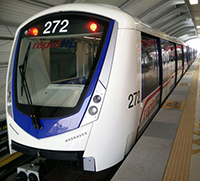|
 On 29 December 2016, Bombardier announced the launch of the latest INNOVIA Metro 300 train in the Asia-Pacific region. The new train entered service on the extended Kelana Jaya Light Rail Transit Line in the metropolis of Kuala Lumpur, Malaysia (Figure 4). On 29 December 2016, Bombardier announced the launch of the latest INNOVIA Metro 300 train in the Asia-Pacific region. The new train entered service on the extended Kelana Jaya Light Rail Transit Line in the metropolis of Kuala Lumpur, Malaysia (Figure 4).
“This new train is the first of 14 INNOVIA Metro 300 trains ordered by Prasarana (the asset owner and operator of Malaysia's two light-rail transit networks-Kelana Jaya Line and Ampang/Sri Petaling Line) to expand the fleets on the Kelana Jaya Line,” said Jayaram Naidu, head of sales and marketing for South East Asia at Bombardier Transportation.
“The vehicles will boost the rail network's capacity by 30% once fully delivered,” Naidu continued. “This will greatly enhance public transport connectivity in the growing city of Kuala Lumpur, supporting the government's vision of an integrated urban mass rapid transit system.”
Designed for driverless operation, the vehicles are equipped with linear-induction-motor (LIM) propulsion technology, which allows for operation on tighter curves with less noise and greatly reduced wheel and track wear. Low energy consumption is achieved with the combination of lightweight aluminum car bodies and the LIM propulsion system. Regenerative braking uses energy released during braking to save power.
These Bombardier INNOVIA Metro 300 cars are equipped with onboard camera systems, infotainment liquid crystal display screens, and dynamic route maps. The four-car trains being supplied to Kuala Lumpur have wide aisles and walk-through gangways (Figure 5), which allow passengers to move freely throughout the train, an innovation first introduced on the Brooklyn Manhattan transit D-type subway cars in 1925 in New York City.
This innovation was never used in New York City after the D-type equipment went into service, although it has been used in several transit systems around the world to equalize passenger loads throughout the train. Interestingly, New York City's Metropolitan Transportation Authority is considering reintroducing the feature on new cars ordered for the New York City Transit division.
Full article: IEEE Vehicular Technology Magazine, Volume 12, Number 2, June 2017 |